Fire in the Forest: Part 1
For many, the phrase “forest fire” will invoke images of large conflagrations in western North America or other parts of the world. Depending on one’s age, one may recall Yellowstone National Park in flames during 1988, parts of Los Alamos lost to the Cerro Grande Fire in 2000, the destruction of Paradise, California to the Camp Fire in 2018, and most recently, the massive bushfires that swept through Australia (i.e., the Black Summer) last year and earlier this year. Tragic for destroying human lives and property, these fires remind us that forests and fire are intractably linked and that our efforts over the past several decades to suppress fire (i.e., the “Smoky Bear era”) have only made those forests more susceptible to wildfire and/or increased the size and intensity of any fire that starts. In fact, periodic, lower intensity fires can promote ecological resilience of these forested ecosystems, making them much more resistant to wildfire.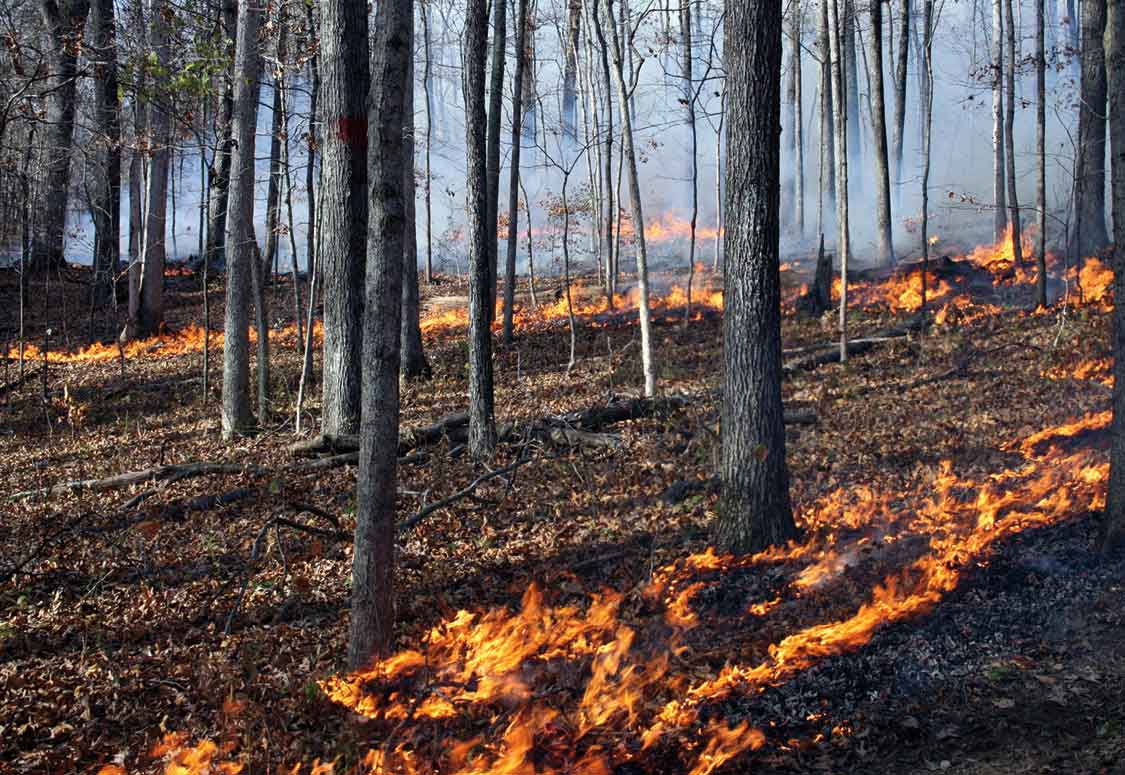 Figure 1a: Low-intensity prescribed surface fire in an Indiana oak-dominated forest. Photos by Mike Saunders
Figure 1a: Low-intensity prescribed surface fire in an Indiana oak-dominated forest. Photos by Mike Saunders
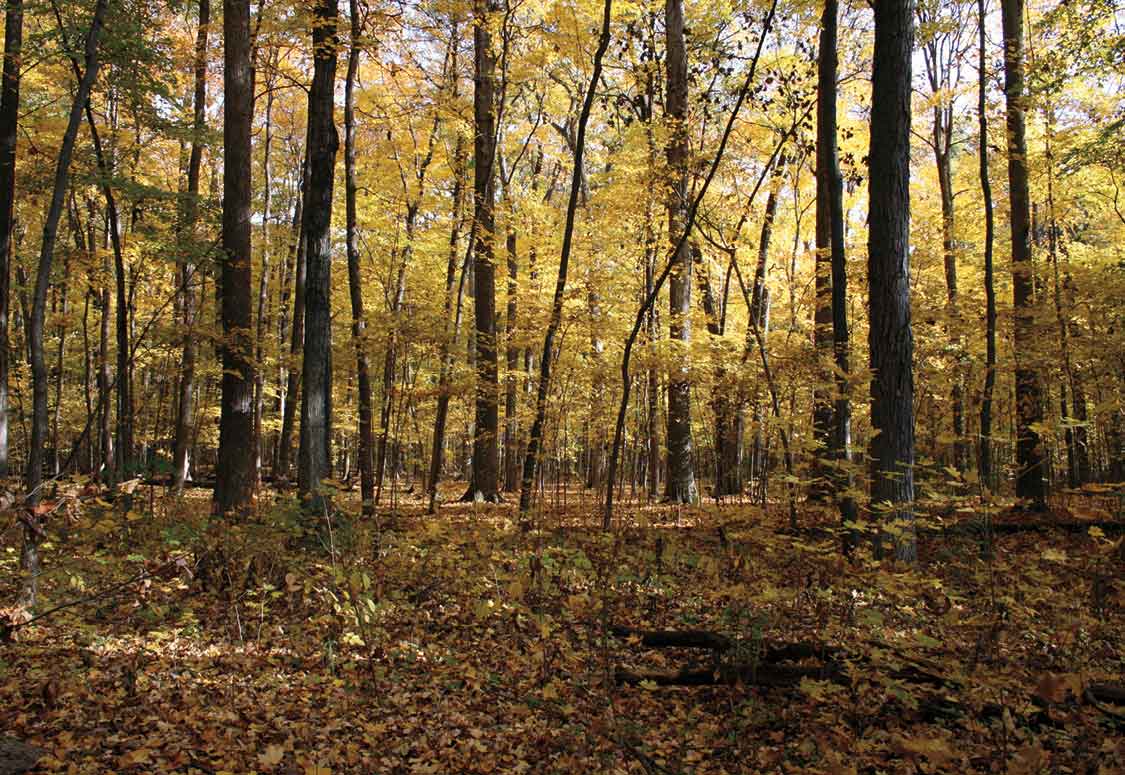 Figure 1b: Without fire, many oak-dominated forest will succeed to maple over time. Photos by Mike SaundersEastern deciduous forests are no different and are promoted by periodic fire. Our oak-hickory forests, for example, were borne of surface fires (Figure 1a), generally returning every 3-15 years, that would keep understories open, kill many fire intolerant competitors, and overall, maintain their composition and structure. Over the past 50+ years, fire has been excluded from many of these forests, leading to sustained lack of oak regeneration throughout forests in the eastern U.S. Forests are becoming “maple-ized” as shade-tolerant, mesic species build up in the understory (Figure 1b). Ecologists and forest scientists warn that there is a landscape-level forest conversion to maple-beech dominated forests currently underway throughout Indiana and surrounding states.
Figure 1b: Without fire, many oak-dominated forest will succeed to maple over time. Photos by Mike SaundersEastern deciduous forests are no different and are promoted by periodic fire. Our oak-hickory forests, for example, were borne of surface fires (Figure 1a), generally returning every 3-15 years, that would keep understories open, kill many fire intolerant competitors, and overall, maintain their composition and structure. Over the past 50+ years, fire has been excluded from many of these forests, leading to sustained lack of oak regeneration throughout forests in the eastern U.S. Forests are becoming “maple-ized” as shade-tolerant, mesic species build up in the understory (Figure 1b). Ecologists and forest scientists warn that there is a landscape-level forest conversion to maple-beech dominated forests currently underway throughout Indiana and surrounding states.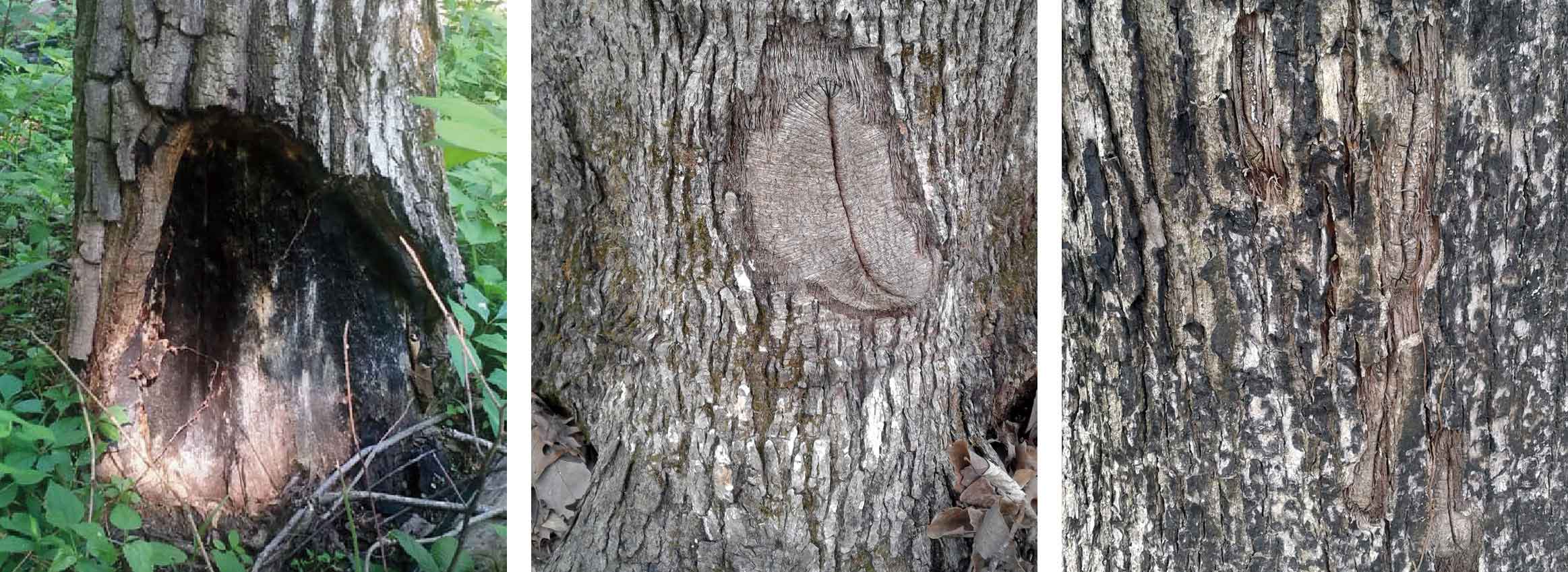 Figure 2. Example of wounds commonly caused by prescribed fire: left catface, center oval (closed) and right seams. Photos by Shannon Stanis and Mike Saunders
Figure 2. Example of wounds commonly caused by prescribed fire: left catface, center oval (closed) and right seams. Photos by Shannon Stanis and Mike Saunders
Some public land managers, therefore, are becoming more interested in the use of prescribed fire to maintain oak forests. For example, the Hoosier National Forest now burns between three and five thousand acres per year, with plans to double that amount in upcoming years. This interest, however, is not ubiquitous; some public agencies and many private landowners are quite hesitant to use prescribed fire in mature oak forests. Reasons cited range from logistical and legal constraints to human health concerns (e.g., smoke) to environmental impacts.
Timber damage
Most silvicultural treatments that a forester may apply to the stand have benefits as well as drawbacks. Fire is no different; if misapplied, it has the potential to cause significant financial loss to the landowner through loss of timber quality and economic value of the stand. Reeves and Stringer (2011) reported, for example, that fire caused average volume losses of 38% and value losses of 47% in oak forests of Kentucky. Earlier studies suggested that value losses could approach 70% in some drier oak forest systems (Burns 1955). However, these and most other research in hardwood-dominated forests quantified wildfire impacts on timber quality and value, not prescribed fire. Prescribed fire, particularly if done to promote oak regeneration, is managed at a significantly lower intensity than wildfire; target flame heights are much lower, typically three feet or less. Prescribed fire is often applied in the fall after leaf-drop or in the spring before canopies develop on the overstory trees; most growing season burning is either impossible because of wet conditions or simply avoided because fires are difficult to control in droughty conditions.
Methods
So what is the impact of prescribed fire on timber quality and economic value of oak-dominated hardwood stands? Over the past four years, graduate students in my lab has been quantifying the amount of timber damage stands received from past prescribed fires on several National Forests across the Midwest. We inventoried 111 stands that had received one to six prescribed fires over the past 25 years, and inventoried an additional 28 stands that had no history of prescribed fire (i.e., to estimate the background incidence of timber damage). For several trees within each stand, we quantified size, species, and merchantable sawlog height. We measured the size of all wounds on each tree below breast height (i.e., 4.5 feet), determining if each was caused by fire or from other factors through characteristics of the wound (e.g., presence of char or shape of the wound; Figure 2). We also graded each tree with two USFS hardwood tree grades (Hanks 1976), one considering all wounds and the other ignoring those wounds caused by fire (following Loomis 2008). In total, over 8,000 trees were measured.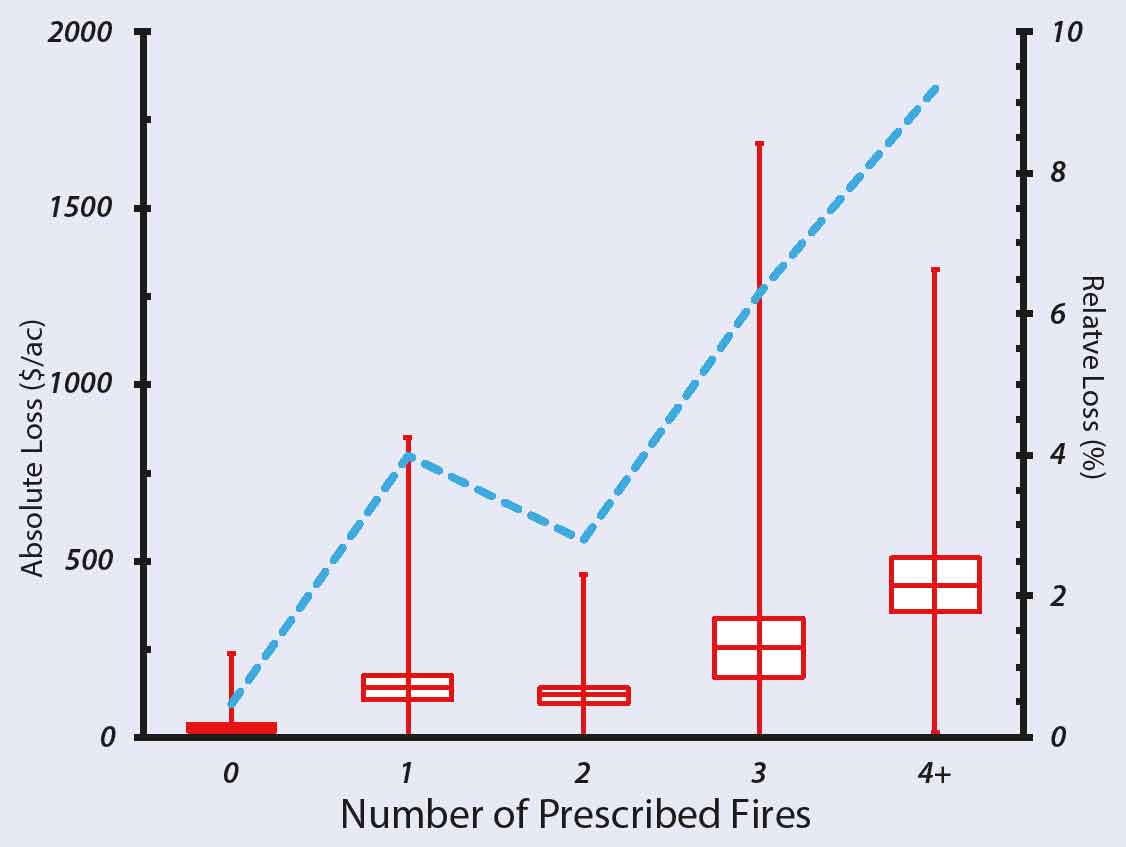 Figure 3. Observed stand-level losses in value due to repeated prescribed fires, both in absolute (red) and relative (blue) amounts. Boxes show the mean plus and minus the standard error of the observations; the whisker lines show the entire range of observed values for each burn category. Both values are based only on the 16-ft butt log for each tree.
Figure 3. Observed stand-level losses in value due to repeated prescribed fires, both in absolute (red) and relative (blue) amounts. Boxes show the mean plus and minus the standard error of the observations; the whisker lines show the entire range of observed values for each burn category. Both values are based only on the 16-ft butt log for each tree.
For each tree, we calculated 1) gross tree volume and gross tree stumpage value, which ignored volume losses and grade defects due to prescribed fire damage; and 2) net tree volume and net tree stumpage value, which reflected observed volume and grade that included prescribed fire damage. Stumpage values used regional averages from 2014-2018 for the various species groups and USFS tree grades. Tree-level statistics were then summarized to the stand-level and relative losses for both volumes and stumpage value calculated (i.e., relative volume loss = (absolute – net)/absolute). See Stanis et al. (2019) and Mann et al. (2020) for more details on these inventory methods and calculations.
Results and Discussion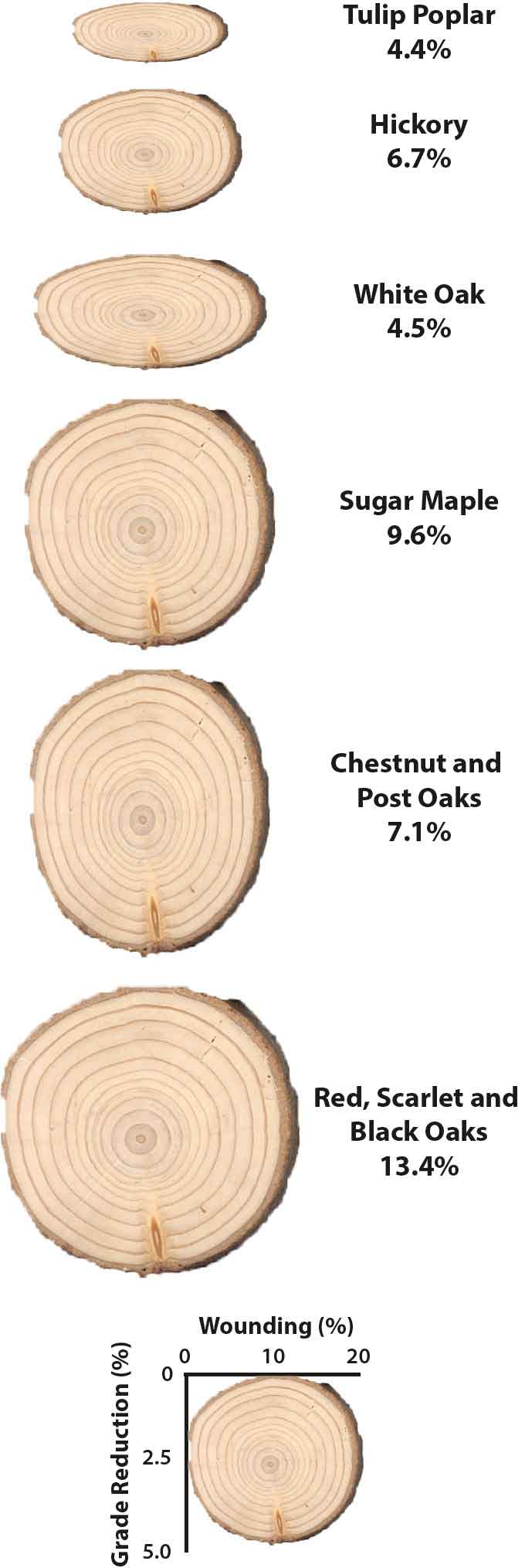 Figure 4. Observed wounding rate (horizontal width; %) and grade loss (vertical height; %) by species group within our sample. Relative stumpage value loss, on a per acre basis, is given in parentheses for each group.
Figure 4. Observed wounding rate (horizontal width; %) and grade loss (vertical height; %) by species group within our sample. Relative stumpage value loss, on a per acre basis, is given in parentheses for each group.
There are several key findings from this research. First, although a significant number of trees will be wounded from fire, most wounds will be very minor, leading to little stumpage volume loss and a very low incidence of grade reduction. Averaged all national forests and burned study sites, approximately 25.1% of trees were wounded and 5.7% of trees had grade reduction from prescribed fire. Both wounding and grade reduction increased with more prescribed fire on a site, from 24% wounding and <8% grade reduction on site that burned two times or less to >40% and >11%, respectively, on sites with three or more applications of fire. Regardless, most individual prescribed fire wounds reduced scaled volume by less than 5 bd ft, although we rarely observed some wounds, particularly more open wounds such as catfaces and ovals, reducing tree-level volumes significantly more, by up to 340 bd ft. Almost all wounds were within a single face of the butt log; therefore, USFS tree grade was often unaffected. Furthermore, given that almost all prescribed fire-caused wounds are within the first few feet of height, we argue that a vast majority of these minor wounds would be removed during milling while squaring up the butt log, so we may be over-estimating the actual volume of defect in these trees.
Second, prescribed fire has only minor effects on stand level timber yields and stumpage value, but the effects increased roughly proportionally with repeated burning. In absolute terms, we observed a total volume loss between 0 and 2,269 bd ft per ac (International ¼” scale) across all our burn sites, with 70% or more of the volume loss occurring in the 16-ft butt logs of the trees. Losses in stand stumpage values mirrored the observed volume losses (Figure 3), largely because of the low proportion of trees with grade reductions. These losses, however, represented a small fraction of the estimated stumpage volume and value of stands, generally less than 10% (Figure 3).
Location does matter, however. Although we observed only minor effects of aspect (i.e., south-facing vs. north-facing slopes) on fire damage, there were pronounced differences between national forests. The Mark Twain National Forest in Missouri had 6 to 15 times greater damage and volume loss than the Hoosier (Indiana), Wayne (Ohio) and Daniel Boone (Kentucky) National Forests. For example, one could expect 15.5% stumpage value loss in Missouri forests as opposed to <3% farther east. Obviously drier average conditions and different species mixtures contribute to these differences, but there likely are differences between use of fire in Missouri forests and those sites farther east. For example, woodland creation and promotion of shortleaf pine regeneration all require higher fire intensities (and resulting higher damage) than use of fire strictly for oak regeneration.
Lastly, we observed differences among species in their susceptibility to damage from prescribed fire (Figure 4). Surprisingly, tulip poplar was most resistant to damage and value loss. However, this was a function of the size of the tulip poplar; all stems surveyed exceeded 20 inches in diameter. At this size, tulip poplar has very thick bark and is resistant to fire. We presume smaller tulip poplar stems, with much thinner bark, at our sites had been killed by past prescribed fires. Of the remaining species, hickories and white oak were most resistant, depending on metric. Hickory was least wounded, while white oak had lower grade change and overall relative value loss. White oak’s resistance to fire damage, in particular, is well known; the species has very thick bark at most sizes and is superior at compartmentalizing and healing wounds. The most susceptible group to prescribed fire damage was the red oaks. All were easily wounded, had high grade loss and high relative stumpage value loss (Figure 4).
Recommendations
Our observations indicate that, in most circumstances, prescribed fire has a minor deleterious effect on timber quality in Indiana and surrounding states, and that only repeated burning is likely to cause major damage to timber. Overstory trees, particularly white oak, have thick bark that insulates the tree from damage and, if damage does occur, can quickly compartimentalize the wound, preventing the spread of decay, and heal over the injury. However, we do warn that more intense fires applied to dramatically reduce midstory densities or kill overstory trees, as would be prescribed for woodland creation, would likely cause more significant damage that we observed in our sites (i.e., similar or exceeding what we observed in the Missouri stands). Target flame height of 3 ft or less in a prescribed burn is likely to achieve many of the goals needed for oak regeneration prior to overstory removal on many sites; exceeding that threshold would likely induce higher levels of damage.
Still, we caution use of prescribed fire on sites with very high quality trees, such as prime and veneer grades, as the USFS tree grades used in our survey do not adequately capture these grades (Stanis et al. 2019). Grade degradation of a few, or even a single, trees per acre in these grades could quickly accumulate to high losses in stumpage value of a stand. For these very high-quality individuals, consider raking litter and duff away from the base of the tree (3-4 ft is generally adequate) and remove any branches or other large pieces of deadwood that are leaning against the stem.
While damage to timber does occur from prescribed fire, in many cases the benefits of the practice outweigh the costs in terms of loss to timber quality and value. In future articles, we will address these benefits on oak regeneration, wildlife populations and habitat diversity.
Mike Saunders is an Associate Professor of Hardwood Silviculture in the Department of Forestry and Natural Resources, Purdue University. David Mann is a and Research Associate in the Department of Forestry and Natural Resources, Purdue University.
References
Burns, P.Y. 1955. Fire scars and decay in Missouri oaks. Bull. 642. University of Missouri, Agriculture Experiment Station, College of Agriculture, Columbia, MO. 8 p
Hanks, L.F. 1976. Hardwood tree grades for factory lumber. USDA Forest Service Res. Paper RP-NE-333, Northeastern Forest Experiment Station, Upper Darby, PA. 81 p.
Loomis, R.M. 1974. Predicting the losses in sawtimber volume and quality from fires in oak–hickory forests. USDA Forest Service Res. Paper RP-NC-104, North Central Forest Experiment Station, St. Paul, MN. 6 p.
Mann, D.P., J.K. Wiedenbeck, D.C. Dey, and M.R. Saunders. 2020. Evaluating economic impacts of prescribed fire in the Central Hardwood Region. J. For. 118(3): 275-288.
Reeves, C. and J. Stringer. 2011. Wildland fires’ long-term costs to Kentucky’s woodlands. Kentucky Woodlands Magazine 6(3): 6-7.
Stanis, S., J. Wiedenbeck, and M.R. Saunders. 2019. Effect of prescribed fire on timber volume and grade in the Hoosier National Forest. For. Sci. 65(6):714–724.
